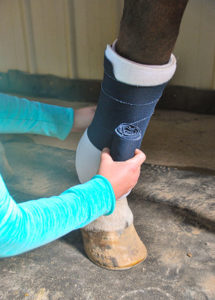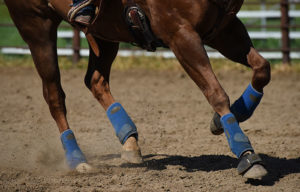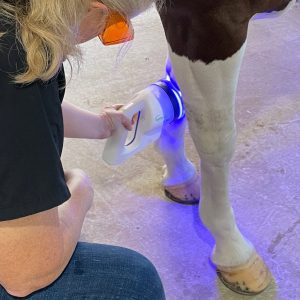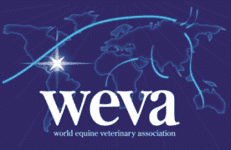Breeding Soundness Exams for Him and Her
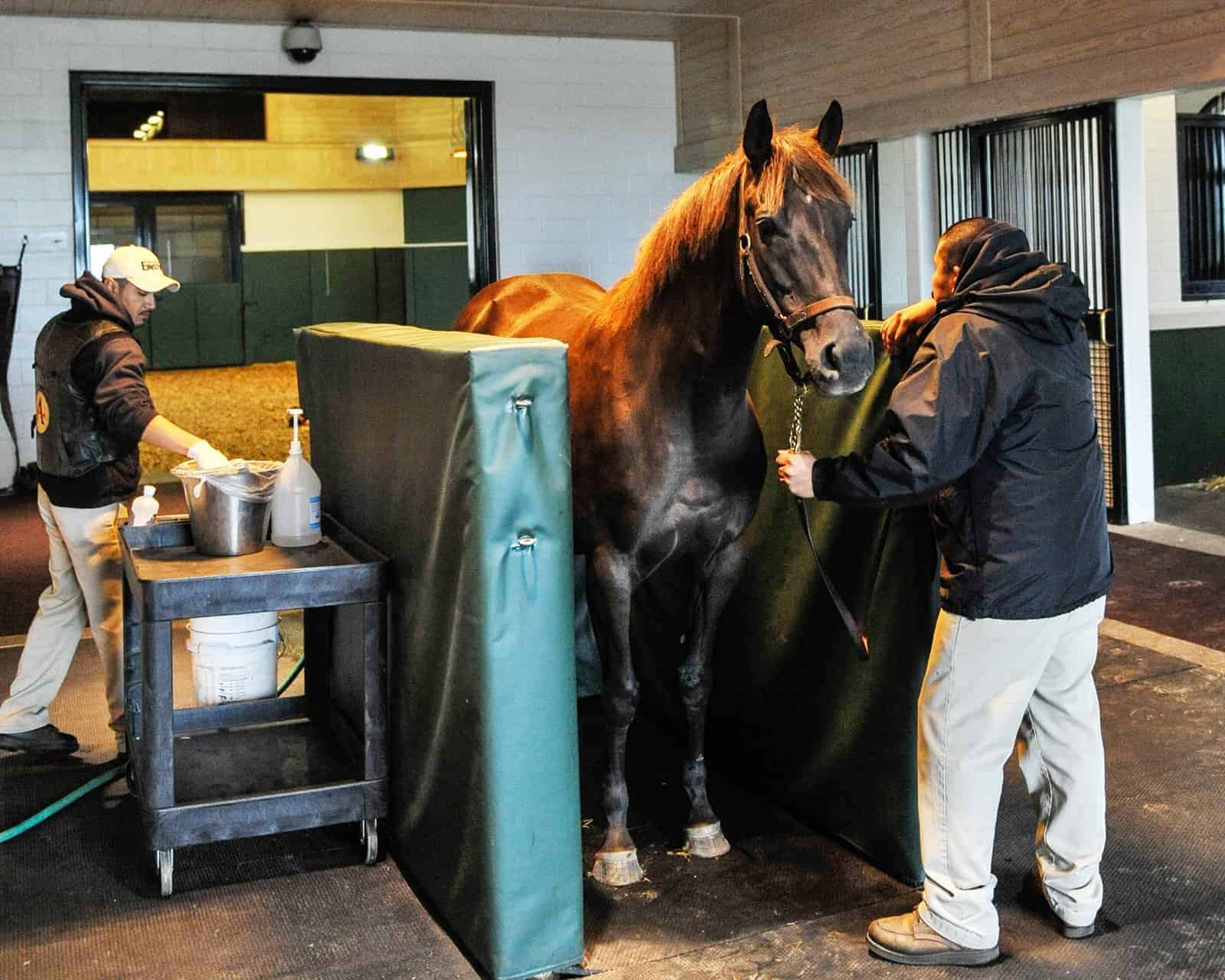
Native Dancer won every race he ran in except for the Kentucky Derby. A true champion on the track, only one thing overshadowed the “Grey Ghost of Sagamore”: his offspring. The stallion sired 43 stakes winners, and his progeny includes champion sires Northern Dancer and Sadler’s Well.
When a truly great horse comes along, it’s only natural to want to replicate his or her talent. Some of us spend decades studying the traits of potential sires and dams to unite in the quest for the “perfect” foal, carefully taking note of the characteristics of progeny already produced. Others don’t consider genetics until they’re in possession of an outstanding horse whose qualities they want to keep around. Either way, it’s critical to do your research before playing Cupid to your horse—and not just in the realm of choosing the parents. A perfect pairing on paper does not a perfect pregnancy and healthy foal make; there are a number of steps you must take to prepare your horse or pony for parenthood. Without further ado, ladies first …
Start With A Healthy Mare
The chances of having a successful pregnancy increase when you have an excellent environment for both conception and fetal growth: a healthy mare. This means making sure she’s up-to-date on vaccinations, deworming, dental, and other preventive care before breeding. And don’t assume that a healthy mare is one that’s “fattened up” to breed. Theriogenologist Karen Wolfsdorf, DVM, Dipl. ACT, of the Hagyard Equine Medical Institute, in Lexington, Kentucky, says you want to be able to “feel a mare’s ribs, but not see them” when breeding season rolls around. If your potential broodmare sports fat pads, a thick neck crest, and a long or poor hair coat, Wolfsdorf recommends having your veterinarian evaluate her for equine metabolic syndrome or Cushing’s disease, as these conditions can affect how she cycles and complicate conception.
And while you might associate broodmares with advanced age—due to many of these mares first having an athletic career—the optimal breeding age for mares is actually 4 to 15, with a slow decline in fertility from 15 to 20. A more dramatic decline occurs from age 20 onward.
Think Ahead
Planning and preparation need to start long before you breed your mare. Once you’ve researched and chosen a stud, you’ll need to arrange physical exams, sign breeding contracts, and think through “first date” logistics. But first there’s the issue of your mare’s ovaries, which can take some coaxing back from their annual winter vacation, called anestrus (when they aren’t cycling).
“It’s no good to pull her out of the paddock in February to start to try to breed her—she’ll have peanut-sized ovaries!” says Wolfsdorf, as opposed to the peach-sized structures they’ll be when they’re releasing eggs in estrus.
Unless you equip your mare with a blue light facemask, which provides artificial light while the mare is out on pasture, “you’ll need to start (stabling) her under lights for about 60 days prior to the time you want to breed her, to simulate the longer spring days that induce horses to start ovulating,” Wolfsdorf continues. “Most horses will start cycling with ovulating under normal conditions by March or April, but if you plan to breed before that, you’ll need to plan ahead.”
In the meantime, confirm that your budget is on target for the stud fees, veterinary procedures, and other costs associated with breeding. If you’re breeding a Thoroughbred with intentions of registering the offspring with The Jockey Club, for instance, live cover is your only option. This means you might have transport and boarding fees to consider, on top of the cost of several transrectal palpations to confirm optimal breeding time and later check for pregnancy. If you opt for artificial insemination, costs vary widely depending on the method (fresh or shipped chilled or frozen-thawed semen), number of attempts to impregnate the mare, and semen transport expenses.
Bring in a Pro for the Exam
Your regular veterinarian can detect common causes of infertility and ensure your mare is ready to be bred. A prebreeding evaluation starts with a careful examination of the horse’s perineal conformation, checking to be sure the three major barriers to infection—the vulva lips, the vestibule-vaginal fold (or hymen), and the cervix—are all working together to expel and seal out feces, air, and bacteria. Older veteran broodmares are more prone to sucking such contaminants into the uterus, as their reproductive conformation will be “a bit saggier due to having numerous foals,” notes Wolfsdorf. “On the other hand, the tighter cervix of a maiden mare can also present difficulties with accumulation of fluid after breeding if the cervix does not relax properly.” Your veterinarian can evaluate your mare’s perineal conformation and help you take appropriate actions to mitigate any problems.
Once your veterinarian has performed the precursory physical exam, he or she will move on to rectal palpation and an ultrasound. This can help you determine when a mare’s cervix is open, one sign that she’s ready to be bred. (A teaser stallion can also help you determine if a mare is cycling.) During this evaluation your veterinarian will look to be sure the mare has two similar-sized functioning ovaries. Most veterinarians combine palpation and ultrasound with a speculum exam to check the cervix and vaginal walls for inflammation or fluid. Uterine cytology and culture can help the veterinarian diagnose an inflamed or infected uterus, while an endometrial biopsy can help predict the mare’s ability to carry a foal, as well as potential treatments that might help her conceive. A biopsy can also help determine the extent of uterine inflammation or amount of scar tissue, if there is any, along with the health of the blood and lymphatic vessels.
And then there are the test results many stallion owners require for mares booked for live cover, including a clean uterine culture to rule out uterine disease. (Likewise, mare owners might request proof of a clean equine viral arteritis—EVA, a viral disease that can cause fever, respiratory illness, and abortion or birth of weak or sick foals, among other signs—test from stallion owners. If a stallion tests positive for EVA, the mare should be inoculated against the virus at least 30 days prior to breeding.)
While the battery of available tests might seem overwhelming, rest assured: “For most mares, a basic reproductive evaluation is usually sufficient before an attempt to breed, unless additional information is required by the stallion owner,” notes Patrick McCue, DVM, PhD, Dipl. ACT, a professor of theriogenology in the Department of Clinical Sciences at Colorado State University’s College of Veterinary Medicine & Biomedical Sciences. “In younger maiden mares that are going to be bred for the first time, an ultrasound exam can be performed to confirm that she has a normal reproductive tract. Mares with a history of infertility or mares to be bred with cooled transported semen or frozen semen should be examined more closely.”
What if Your Mare has a Problem?
Veterinarians can improve some mares’ subfertility. If a problem stems from a subpar physical barrier, they might elect to perform a Caslick’s procedure; this involves suturing the vulva lips together to prevent feces and air from entering the uterus. The stitches must be removed when it’s time to breed or foal. Your veterinarian can also prescribe progesterone to help the cervix close, further sealing out contaminants. While the surgery is relatively straightforward, it’s one that must be repeated both before and after breeding and foaling, making it less than ideal for mares you’d like to breed year after year, due to convenience, cost, and the finite number of times a Caslick’s can be performed.
If your mare suffers from mating-induced endometritis (inflammation caused by a failure to properly flush semen and other contaminants from the uterus after insemination), your veterinarian might use uterine lavage or oxytocic drugs to help her expel the fluid. Failure to ovulate is another highly treatable fertility issue. Charles Scoggin, DVM, resident veterinarian at Claiborne Farm, in Paris, Kentucky, considers ovulatory failure to occur if the mare has not ovulated as predicted within 48 hours of live cover.
“Most commonly, I administer an ovulatory agent the day before the breeding,” Scoggin notes. “Over 90% of mares will ovulate within two days after administration of one of these agents.”
He also recommends avoiding the use of non-steroidal anti-inflammatory drugs (NSAIDs), as they might interfere with ovulation. “Of course, we do whatever we can for our mares to stay as healthy and happy as they can be,” he says. “That would include ample turnout time, a balanced concentrate, fresh water ad libitum, and not overcrowding the pastures with other horses.” In other words, a happy mare is more likely to be a fertile mare.
First-Date Tactics
If your stallion does not show immediate interest in mounting an in-season mare, he might need to ease into the process. “Many stallions are naive about the breeding environment the first time around,” says Dickson Varner, DVM, PhD, Dipl, ACT, a theriogenologist and professor at Texas A&M University’s College of Veterinary Medicine and Biomedical Sciences. “They may be overly aggressive or may be afraid of the mares and will backpedal if (the mare) approaches. You have to treat each as an individual and know that some may take up to two to three weeks to become interested.”
Finding an experienced, patient mare can help acclimatize a new stallion, as can removing a trainer or rider who might have reprimanded a stallion previously for showing breeding-specific behavior in the show pen or elsewhere. It’s important for a stallion to feel safe and unencumbered—although Varner doesn’t recommend turning the stallion out with mares freely, as “a good kick in the groin could ruin him.”
—Lindsay J. Warner
On to the Gentlemen
First-time studs are subject to similar examinations as maiden mares, starting with a general health and wellness check and proceeding to an evaluation of reproductive organs. Typically veterinarians palpate and ultrasound both testes to ensure they are completely descended and of adequate size. A horse with unilateral cryptorchidism (when one testicle is retained and the other is visible) can still be fertile, but he might pass this undesirable trait on to offspring. Testicular size can be an indication of potential sperm production, notes Dickson Varner, DVM, PhD, Dipl. ACT, a theriogenologist and professor at Texas A&M University’s College of Veterinary Medicine & Biomedical Sciences, but there’s a lot of variability among breeds.
“Ultimately, a stallion becomes a sire for several reasons: pedigree, performance record, and conformation,” he adds. “Notice I didn’t mention anything about reproductive potential; of course you hope he’s fertile, but you often can assist if fertility is an issue.”
Evaluating Breeding Performance
While most stallions can sire offspring with little intervention, it usually pays to collect semen for evaluation once or twice prior to the start of the breeding season each year to be sure none is needed. Key evaluations include sperm concentrate and semen volume (known collectively as the total sperm number), morphology (the physical structure of the sperm), and motility (ability to move/swim). The total sperm number changes throughout the year and is a good indication of the stallion’s daily sperm output, or how good his chances are for impregnating a mare.
“The number of sperm in ejaculate ranges from about 4 to 16 billion,” says Varner. “A typical stallion might have 5 to 6 billion sperm per day if he’s been collected from on a daily basis. You would also want to check numbers after he’s been sexually rested for a period of time.”
Physical defects in sperm—poor morphology—can adversely affect motility. Veterinarians can check the longevity of sperm’s motility, as well, by putting it in a device used for transporting cooled semen, leaving it for 24 hours, then rechecking motility. This test is particularly important for a stallion whose semen will be shipped. In a high-tech lab such as the one in which Varner and his associates work, the veterinarian might also test sperm DNA and proteins.
Dr. Patrick McCue
What if Your Stallion has a Problem?
A wide variety of procedures can be used to improve semen quality in breeds with registries that permit artificial insemination. A veterinarian can use a centrifuge to alter and improve the semen or plasma quality and/or can strategically direct centrifuged semen to the tip of a mare’s uterine horn. Other problems might be physical, such as a stallion’s inability to emit sperm from the deferent ducts, the storage spot and transport portal for semen. To make things even more complex, a physical issue can manifest as poor sperm morphology; if a veterinarian identifies detached sperm heads or sperm with bent tails, that “may be an indication you need to clean his pipes to freshen the reserves of sperm so they’re better quality,” notes Varner.
In looking at solutions, it’s important to note that the root of a stallion fertility problem isn’t always the reproductive system itself. Prior sickness with an accompanying fever, as well as a poor diet, can negatively impact semen quality. A physical problem—such as a sore back or stifle or navicular disease—might also make a stallion hesitant to mount a mare. You can address these types of issues using good management techniques.
Overall, veterinarians can diagnose and improve the gamut of stud fertility issues by either managing the horse differently or providing medical therapy, notes McCue—with the exception of problems associated with advanced age.
“One of the difficult fertility issues to overcome is testicular degeneration,” McCue says. “Advanced testicular degeneration can appear in some middle-aged horses, from approximately age 15 and onward.” In other words, don’t wait too long before trying to breed your stud.
Take-Home Message
Above all, practice patience and good horse management skills when handling a maiden mare or new breeding stallion. Clear communication and positive experiences go a long way in preparing a horse for the breeding season. And good health is the most important of all. So even if you’re not planning to breed your horse immediately, place a premium on his or her health so that when the time comes for Cupid’s arrow to strike, everyone is ready for it.
Written by:
Lindsay J. Warner
Related Articles
Stay on top of the most recent Horse Health news with



